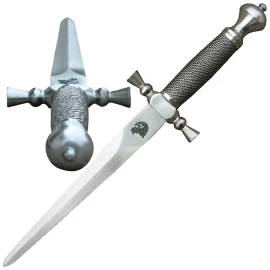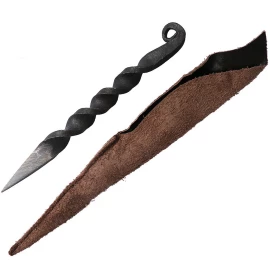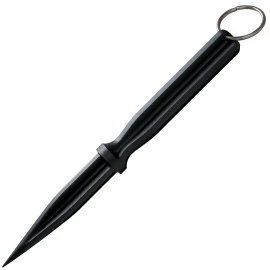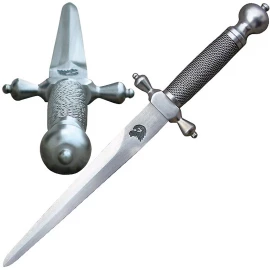Misericorde Dagger
The stiletto was also called misericordia (literally "mercy") began to gain fame during the High Middle Ages, when it was the secondary weapon of knights. It was used to discomfit a fallen or severely wounded heavily armoured opponent. The thin blade could easily pass through most mail or find its way through tiny gaps in a knight's plate armour. More information...
These variants are in stock
Misericorde Dagger
- Overall length approx. 66cm
- Blade length approx. 48,5cm
- Handle length 12,5cm
- Weight approx. 1142g
- The blade is made of 11 mm square-edged steel
- Pointed blade
- Polished finish
- Blade of steel W.Nr. 1.7102 (DIN 54SiCr6) quenched to a hardness of approx. 53 HRC
Made in the Czech Republic.
A severely wounded opponent, who was not expected to survive, would be given a "mercy strike" (French coup de grace), hence the name "misericordia". Later the Gunner's Stiletto became a tool for clearing cannon-fuse touch holes. Used like an automotive oil dip stick, they were often scribed with marks indicating levels of powder charges for ranging distance.comes from the Latin word stilus meaning: "a stake; a pointed instrument".
The Misericorde Dagger was used to dispatch knights who had received mortal wounds, which were not always quickly fatal in the age of bladed combat; it could also be used as a means of killing an active adversary, as during a grappling struggle. The blade could be pushed through the visor or eye holes in the helm with the aim of piercing the brain, or thrust through holes or weak points in plate armor, such as under the arm, with the aim of piercing the heart.
Please read our: Directions for the use of bladed weapons.
We are here for you




















